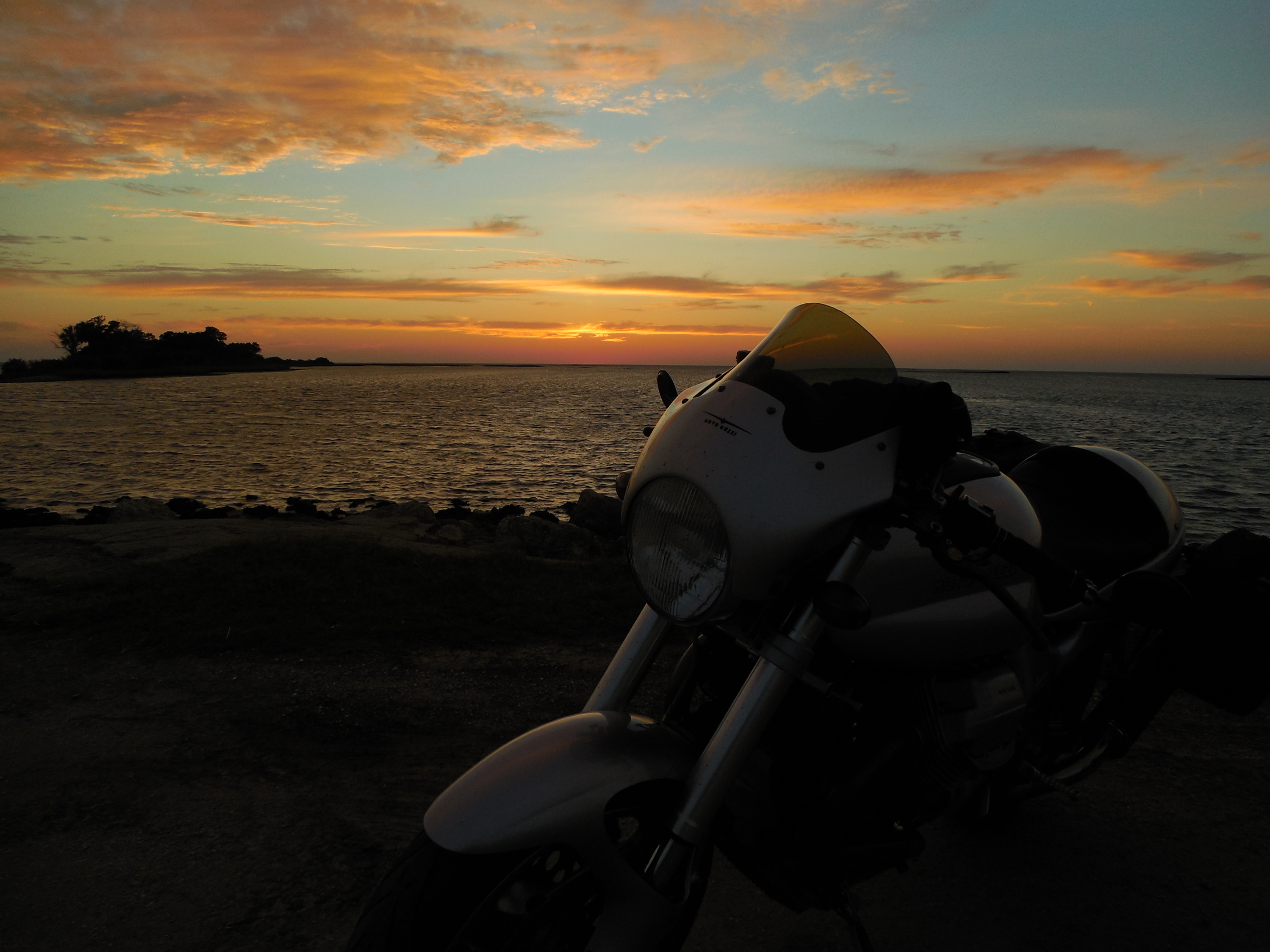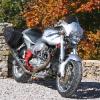-
Posts
18,740 -
Joined
-
Last visited
-
Days Won
1,011
Content Type
Profiles
Forums
Events
Gallery
Community Map
Everything posted by docc
-
Different shaft on the 1100, no? Yet the pinch bolts may be the same (?) The V11 bolts appear to be 8mm. The Workshop Manual shows 25-30 nM for 8x1.25 bolts.
-
Not 'off topic' at all! Relay quality and connectivity remain the #1 biggest improvement an owner can make to these bikes' reliability. Some bikes have "map pockets" in their tank bags, V11s have "electrical diagram/troubleshooting" pockets . . .
-
I remember taking mine apart a several years ago and the threads were *very unhappy*. I reassembled with blue LocTite and the torque spec for the bolt size (are they 6mm or 8mm??) I, then, painted a red line along the bolt heads onto the knuckles so I could monitor if the bolts tried to back out. So far, no.
-
So, what did you 'plug' the hole with (you just plugged one of the two, right)?
-
I've moved mine inside the muffler bracket. No protection . . .
-
Good news, Phil! And all you had to do was unplug the PC? For best results, do at least steps one and two of Tom's list. Then get your shop to do 3-5 (and 6 if they have the software interface). Just adjusting the valves and opening the air screws could help immensely. (steps 1 & 2). You are on Imperial gallons, no? 40 mpg Imperial is 33.4 USmpg if I've got the calculation right (?); pretty typical V11 mileage. The good tuning could be expected to give you another 10%. I love the comment about the ". . . normal 90mph riding.":grin:
-
Yes, they were supplied with spacers of about two inches for the top front mount. Many of us found they were too long and shortened them. Mine are now one inch and hold the bags close and level. They are just mild steel tube stock.
-
Does a two color LED have three leads? Since the neutral switch is a grounding circuit, how would you connect to differentiate whether the current for the run (kill) switch is coming from the neutral switch/relay3 or the sidestand switch? And, oh my, lots of these V11s have had these systems jumpered. I suppose it's best not to stand about in front of them when they're started . . .
-
I think way back in the when-ever, I used blue LocTite on my tripmeter shaft. JB Weld is a two part epoxy with a metal substrate. 15 hour full strength which can then be drilled, milled, tapped or otherwise treated like metal.
-
Yes, I see that hot feed from fuse 5 now. No use using two LEDs there.And, I don't think I've ever heard of Relay1 failing in the open position. Looking at an LED for Relay 3: This LED will light when the relay is closed by the neutral switch, but will also light when the sidestand is up and its switch is closed. The LED would only go out with both the stand down and the gearbox in gear. It would make for an easy check on both the sidestand switch and the neutral switch/relay3 circuits. But you would have to look at the LED first in neutral with the sidestand down (neutral switch/relay3 circuit) and in gear with the stand up (sidestand switch/no relay). Thanks for having a look at that relationship. I first saw this with your Note 13 on the Test Point Layout. Am I seeing that right?
-
Looking back to the original thread topic, it looks like discussing "adjustments to the front (fork)" would still be on topic. So, GuzziMoto, how does one go about modifying the fork damping internally? Is there a thread on that somewhere that I've missed?
-
I understand what you mean by the aspects of damping in the fork travel. And I certainly agree it's not a very sophisticated system. I would count the "large holes" in the early travel as the high speed damping which is, as you say, not externally adjustable. Winding the adjusters appears to make very little difference in practical riding. Lighter oils (again, beware: not all "5wt" is the same!), and spring/sag set-up make the real day to day difference.
-
The template is a good idea. I was thinking of adding an LED to the NO side of the starter relay to show it is live (that would give the one "five pin" relay two LEDs. Still considering colors. Gotta have colors . . . The debate on electrical "lubricants" remains interesting. Dry, white, powdery, or green certainly is the worst case scenario. Mechanites smarter than I have said that silicon dielectric grease is known to infiltrate wire insulation and relays forming the equivalent of glass under heat cycling. I had since converted to copper anti-seize paste, but I'm not really sure what the 'base' paste is.
-
My 2000 clicks and has rebound on the right, compression on the left. But, it is notable, that these adjustments only affect the slow speed damping. High speed damping can only be changed with internal valving or oil viscosity. Per previous discussion, be alert to evaluating oil by CentiStokes, rather than the less sensitive SAE weights. Springing and preload (sag) remains the key!
-
5,000 is the sweet spot, yet I usually roll along indicating between 4500 and 5k, and sixth gear pushes the speedometer into Certain Court Date. Remember, many of the white face Veglia tachs are optimistic by 300-500 rpm. Lower rpm means lower charging rates, less oil flow, and more power pulse beating into the gearbox.
-
So, Roy, What gauge wire for the LED? I'm thinking something as small as 18g . . . Also, how did you route the ground wires? All into one wire? All back to one terminal? To the battery? (I'm thinking of using different color LEDs just for show!)
-
And here I thought Swedish women were the antidote for those long Stockholm winters . . .
-
You guys are amazing. And capable, too. Keep this equation in mind as well: + =
-
You're going to enjoy it much more if you get both the front and rear in the target sag range (the right springs and preload for your weight). Plus your front forks will benefit from an oil change and, generally, lighter oil. There are some really long drawn out debates on all this in the old threads, but one of the best things you can get sorted out on your Sport.
-
Those Sport guys . . . bunch of renegades, they don't want to be registered; like a collie. Absolutely wild and untamed; those Sport guys . . .
-
Wow! Ain't she sweet with those AC Cobras!!
-
No, no little screw on your ECU. Your CO trim will have to be adjusted with a software interface (Axone or VDSTS). As delivered, my Sport was " -27"; bringing it to "0" brought the idle up several hundred RPM and made it more stable. Fuel economy did not change. 460 mV seems low for idle. Another advantage to the software interface is to read the RPM from the crank sensor and compare to the indicated RPM on the tachomater. Early (Veglia) tachs often read 300-500 RPM high. The result is that you should tune with the correction in mind. In other words, a 300 RPM high indication would dictate you set your idle at an indicated 1450. Happy idle=happy oil=happy charging.
-
At six weeks out, it looks like there are six riders already registered at the Tellico Lodge. Already, two or three will have their wives along and we'll get to meet one fellow's young son! There are two or three others riding over from Columbia that will split off for the Keith Code Track School at Barber's on the new BMW sportbike. There are often a couple who drop in on us unannounced just cause that's their style!. So far, I'm counting four spine frames in the mix. They've become so valuable and vintage no one really wants to bring them out of the garage . . .. They're like Vincents, you know . . . Really, if you're anywhere close, come on by at least for the evening on Friday or Saturday and we'll all compare oil hose routing . . . or you could go ride 195 hp BMWs in Alabama (tough call, I know . . .) Ride well, docc
-
AAuuughgh!!! Now I've got Double Guzzichondria! :o


